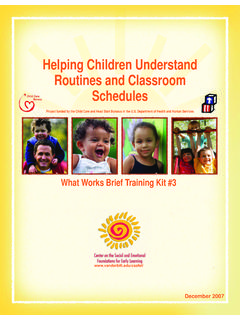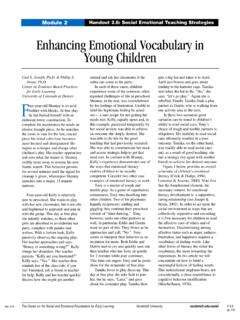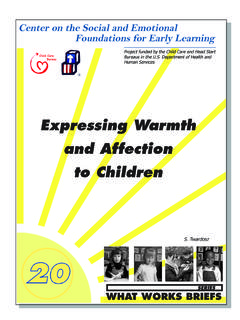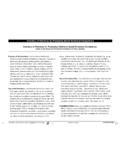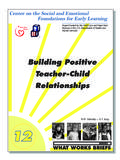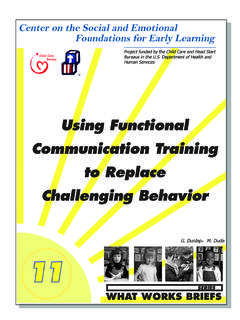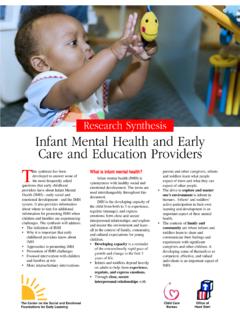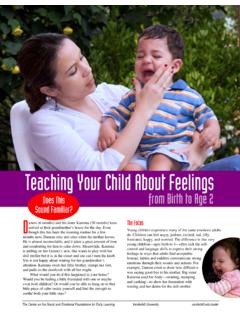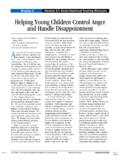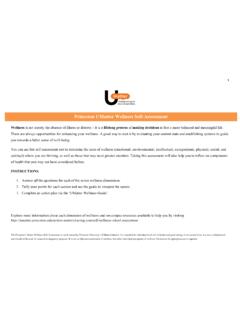Transcription of Helping Children Make Transitions between Activities
1 Center on the Social and EmotionalFoundations for Early LearningProject funded by the Child Care and Head Start Bureaus in the Department of Health and Human ServicesSERIESWHAT WORKS BRIEFS4 Helping Children Make Transitionsbetween ActivitiesM. M. Ostrosky E. Y. Jung M. L. HemmeterThis What Works Brief is part of a continuing series of short,easy-to-read, how to information packets on a variety ofevidence-based practices, strategies, and interventionprocedures. The Briefs are designed to help teacherssupport young Children s social and emotional include examples and vignettes that illustrate howpractical strategies might be used in a variety of earlychildhood settings and home times a day young Children move from one activity to another in their early childhood classrooms. For example, atGlendale Early Childhood Center, Children are greeted as they get off the bus. As they emerge from their buses, the childrenin Ms. Karen s preschool classroom gather around the playground fence and sing songs until all five buses have come and the 15 preschoolers prepare to walk to their classroom, Ms.
2 Karen reminds the Children to use inside voices and to stay alongthe right side of the hall so other teachers and Children can pass by. She also suggests that Cameron and Elizabeth hold hands,knowing from past experience that Cameron will have an easier time moving down the long hall if he has a buddy close by the preschoolers round the corner and see their classroom and cubbies, they get busy hanging up coats and backpacks,handing notes from home to Ms. Karen and Ms. Ellie (the teaching assistant), and selecting books to look at on the carpeted child, Daniel, typically needs a little extra help removing his coat, so a teacher is always nearby to assist Daniel so he won tbecome frustrated, yet will continue to become more independent. As Children begin moving to the large carpeted area withbooks, Ms. Ellie joins them while Ms. Karen stays with the group needing a little extra time and help at their cubbies. Ms. Elliehas arranged numerous books about fire trucks and fire stations on the rug for the Children to make a selection.
3 Ms. Jimenez,Lily s mother, has even lent the class three books about fire trucks, written in preschoolers became very interested in fire trucks a few days before when a small garage nearby caught on fire and three fireengines went racing by the classroom window. Ms. Ellie begins having conversations with the Children about the trucks, hoses,fire house dogs, and other things they see in the books. She asks them questions about their experiences with fire trucks and shepoints to different objects in the books ( , fire hydrant) as she says the name so the Children hear the words and connect them tothe pictures. While the Children are looking at books, Omeed, a child with autism, has begun to get restless. Ms. Ellie calmlybrings him onto her lap, hands him a plastic fire truck, and begins turning the pages of the fire house book he has selected. SoonMs. Karen joins the others on the carpet and pulls out the photo schedule to show the Children what will happen today.
4 They begintalking about centers that are open, and the Children start making choices and moving to the different play Are Transitions between Activities ?For some young Children , moving from one activity to another( , bus to classroom, cubbies to book reading, art time tolunch) results in confusion, frustration, and challenging behav-iors. Caregivers such as Ms. Karen and Ms. Ellie apply a varietyof strategies to help Children make smooth, independent thinking about Transitions , caregivers might ask them-selves questions such as: How do I prepare Children to move from one activity orsetting to another? Do I plan my daily schedule to include transition times andconsider what the Children and adults in the setting will doduring these times? What Activities such as singing, playing word or guessinggames, reciting rhymes, or doing finger plays can I do withthe Children in my care so the time passes more quickly asthey wait for the bus to come, for other Children to finishusing the bathroom ( , if location requires the entire classto toilet at the same time), How do I meet the individual needs of Children who mightneed more support or different types of support duringtransitions ( , photos to help them anticipate what activityis next, directions given in a child s home language or signlanguage, an individual warning to a child that soon it will betime to clean up and begin a new activity)?
5 Do I have too many Transitions between Activities ? Do Children become frustrated at not having enough time tofinish a project or activity? How do I help Children become more independent across theyear as they make Transitions from one activity to another( , gathering backpacks and putting on boots, picking uptoys)? Do I provide positive attention to the Children following thetransitions that go smoothly ( , the times that Children pickup the toys without prompting)?Strategies that support smooth Transitions between activitiesinclude verbal cues such as verbal reminders before Transitions ( , 5 minutes before snack time, it s almost time to cleanup ) and positive feedback after Transitions ( , Nicholas andJorge did a great job cleaning up the block area and moving tothe carpet. ). Nonverbal cues ( , showing pictures of the nextactivity, ringing a bell) are another frequently used strategy tohelp young Children make smooth Transitions . Adults also letchildren move individually from one area to another area whenthey are ready to avoid making Children wait for the entire groupto get ready.
6 For example, as Children finish hanging up theirbackpacks, Ms. Ellie encourages them to go to the carpet andchoose a book. Adults also consider activity sequences byplanning a gradual increase or decrease in the level of activity( , gross motor Activities such as gym or outdoor play fol-lowed by snack) and a good balance of active and quiet play( , center or large group time followed by story time). Inaddition, adults teach peers to help Children who have a hardtime during Transitions . For example, Children such as Cameronand Elizabeth may move in pairs from one activity to another, oradults may prompt one child to help another child gather his/herbackpack. Caregivers also help Children self-monitor so theybecome more independent at moving between Activities . Forexample, Children can be asked to reflect on how quietly orquickly they moved from one activity to another ( , Yoshi,what did you do when you heard Ms. Forbes ring the bell? ).When implementing different approaches to facilitate Transitions ,it is important that adults praise Children after Transitions arecompleted to help Children learn practices are those strategies, documented byresearch, that have been shown to work with young is important that work with young Children and their familiesis based on evidence-based practices.
7 Researchers have shownthat planning for and supporting Transitions between Activities isbeneficial to young Children . Care must be taken in adaptingtransition strategies to meet the individual needs of youngchildren and the cultural and linguistic diversity of the familiesserved within the Is It Important to Address Transitionsbetween Activities ?Research studies have suggested that Transitions take a great dealof time but that caregivers tend not to plan for transition timewhen they plan their schedules. During transition time, childrenoften spend much time waiting to move to or begin the nextactivity in preschool classrooms, child care settings, and homesettings. For example, all Children might be required to wait untileveryone has finished snack or lunch before moving to the nextactivity, or Children might be expected to wait for buses quietlyfor time periods that cause even the most compliant preschoolerto become fidgety! Some Children have stressful and frustratingexperiences making smooth and independent Transitions betweenactivities.
8 They might be reprimanded multiple times fortouching things on the wall, poking their peers, talking, orsquirming during Transitions between preschool teachers and other caregivers considerchildren s ability to independently make Transitions betweenactivities one of the essential skills needed in group contextssuch as kindergarten and preschool. Skills such as putting on andtaking off a jacket, cleaning up toys, and lining up reducetransition times and leads to more time for Children to becomeengaged in learning Activities . As Children become more inde-pendent and more focused on what they should be doing, weare less likely to see problem Are the Children Who HaveParticipated in Research on Transitions ?Like all areas of research, studies on transition strategies havebeen conducted with a limited group of Children in certainsettings. Care must be taken to determine if strategies areculturally, linguistically, and individually appropriate for thechildren in your care.
9 For example, some Children may have hadlimited opportunities to independently choose and look throughpicture books and might need more adult support and supervi-sion. The importance of adapting strategies to meet the needs ofthe Children and families in your care cannot be we take a peek into Ms. Karen s classroom threemonths later, we see that most of her students areindependently hanging up their backpacks and getting readyfor the day by placing their belongings in their cubbies withlittle or no assistance. We also note that Children move fairlyindependently when told that it is time to clean up. Forexample, they sort and put blocks on the correct shelves,clean up art supplies, and put puzzles together beforereturning them to the shelves and plastic bins. Additionally,we see Children taking Omeed s hand and bringing him tosnack and Helping him to line up when it is time to gooutside. They support Omeed without any cues from theteachers. When we look at Ms.
10 Karen s daily planner, we seethat she consistently plans for transition times by notingsongs to be sung as Children wait for others to arrive at thecarpeted area from snack, finger plays to do as Children waitfor the buses to arrive at the end of the day, and word gamesto play as Children move to the gym. Ms. Karen and Ms. Ellieknow that these transition strategies help prevent challengingbehaviors because young Children are actively engaged, theyare too busy to look for other things to do! These teachershave seen their students become more independent as theyear progresses and they know that careful and thoughtfulplanning across the day has contributed to this practices are those strategies,documented by research, that have been shown to work with young Children . It is important that workwith young Children and their families is based onevidence-based preschool teachers and other caregivers considerchildren s ability to independently make transitionsbetween Activities one of the essential skills needed ingroup contexts such as kindergarten and on the Social and Emotional Foundations for Early do I Find Information on Implementing This Practice?
